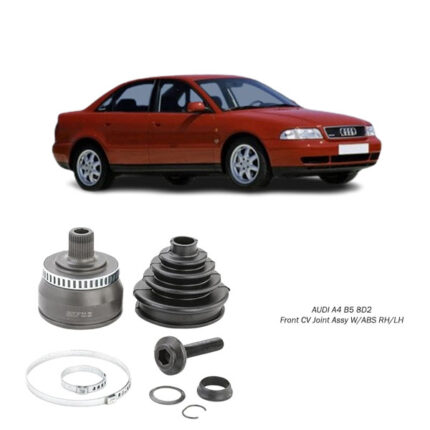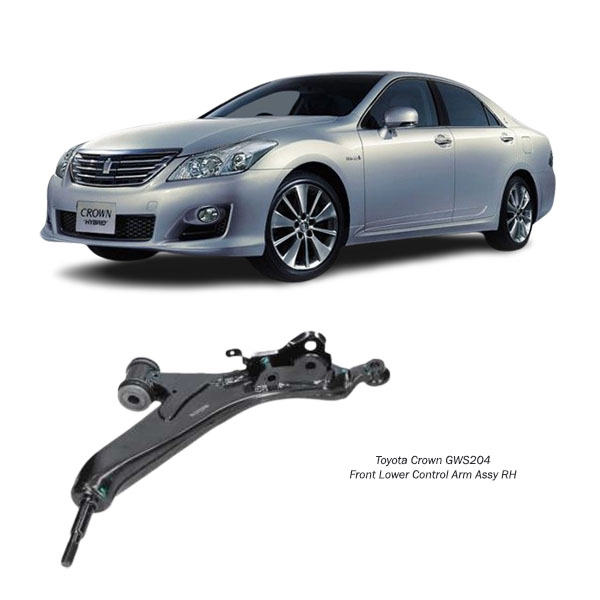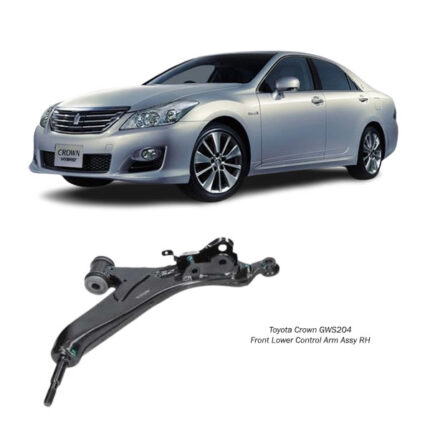Get Toyota Crown GWS204 Front Lower Control Arm Assy RH 48620-30290 in Kenya
The Front Lower Control Arm Assembly (RH) is a foundational component of a vehicle’s front suspension system. Positioned on the right-hand side (passenger side) of the front axle, this part serves as a critical connection between the vehicle’s chassis and the steering knuckle or wheel hub assembly. While it’s a part often overlooked by non-mechanics, the control arm plays a key role in maintaining proper alignment, absorbing road shocks, and ensuring smooth handling.
Understanding how this component works, the benefits of a good one, the risks of a faulty one, and signs of wear can help ensure optimal vehicle performance, ride comfort, and—most importantly—safety.
What is a Front Lower Control Arm Assembly (RH)?
A lower control arm assembly is a robust, usually A-shaped or L-shaped metal component mounted to the vehicle’s frame at one end and connected to the wheel assembly at the other via a ball joint. It typically includes:
-
The arm itself (usually steel or aluminum)
-
Rubber or polyurethane bushings at the frame-mount side
-
A ball joint at the wheel-side connection point
The assembly allows the wheel to move vertically (up and down) with the suspension travel while maintaining proper horizontal alignment with the chassis. It provides flexibility, absorbs shocks, and plays a central role in the suspension geometry, making it a vital part of vehicle dynamics.
On the RH (Right-Hand) side, the control arm ensures that the passenger-side front wheel stays aligned and connected while navigating bumps, turns, and acceleration.
Function of the Front Lower Control Arm Assembly
-
Connects Suspension to Frame:
The control arm physically links the wheel hub/steering knuckle to the car’s chassis. It acts like a hinge that lets the wheels go up and down in response to road conditions. -
Maintains Wheel Alignment:
It helps maintain the correct camber and caster angles, essential for safe and predictable steering. -
Absorbs Shock and Vibration:
The bushings and ball joint absorb road impact and vibration, providing a smoother ride and minimizing stress on the rest of the suspension. -
Supports Steering and Handling:
During turns or braking, it keeps the wheel in position, ensuring the car responds accurately to driver inputs.
Advantages of a Good Lower Control Arm Assembly (RH)
1. Improved Handling and Stability
A good control arm ensures consistent wheel positioning, which translates into better cornering, quicker steering response, and enhanced overall stability.
2. Longer Tire Life
Proper wheel alignment minimizes tire wear. A worn or bent control arm often leads to uneven tire wear and the need for premature replacement.
3. Ride Comfort
Rubber or polyurethane bushings absorb harshness from road irregularities, offering a smoother and quieter driving experience.
4. Enhanced Safety
Control arms keep the wheels planted and aligned, ensuring proper contact with the road. This improves traction and braking performance.
5. Durability
High-quality materials and construction allow the control arm to withstand years of stress, heavy loads, and harsh driving conditions without failure.
Disadvantages and Dangers of a Faulty Lower Control Arm
Neglecting a worn or damaged control arm—especially on the RH side, which often endures road-edge bumps and curb hits—can lead to multiple problems:
1. Poor Alignment and Handling
Misaligned wheels cause steering to pull to one side and reduce overall control of the vehicle.
2. Increased Tire Wear
Excessive or uneven tire wear results from improper wheel geometry and costs more in tire replacements.
3. Suspension Noise
Clunking, knocking, or creaking sounds, especially when going over bumps, can indicate loose bushings or a failing ball joint.
4. Unstable Steering
A compromised control arm causes vague steering feel or even sudden shifts in wheel position, risking loss of control at high speeds.
5. Brake System Impairment
A destabilized wheel can affect the braking geometry, increasing stopping distance or causing brakes to grab inconsistently.
Signs of a Failing Front Lower Control Arm Assembly (RH)
Watch for these symptoms, particularly on the front passenger side:
-
Clunking or knocking noises, especially when going over bumps or during braking
-
Steering wheel vibration
-
Poor handling or pulling to one side
-
Uneven or rapid tire wear
-
Loose or wandering steering feel
-
Visible cracks or wear on bushings or arm body
-
ABS light (in extreme cases where wheel position sensors are affected)
Regular inspection is advised every 40,000 to 80,000 kilometers, depending on driving habits and road conditions.
How to Replace the Front Lower Control Arm Assembly (RH)
While not overly complex for an experienced technician, replacing a control arm requires precision and safety. Here’s a general guide:
Tools Needed:
-
Jack and jack stands
-
Lug wrench
-
Wrench and socket set
-
Ball joint separator or pickle fork
-
Torque wrench
-
Pry bar
-
Hammer (optional)
Steps:
-
Secure the Vehicle:
Park on a flat surface, apply the parking brake, and loosen the RH front wheel lug nuts. -
Lift the Vehicle:
Raise the car with a jack and place it on jack stands. Remove the wheel completely. -
Locate the Control Arm:
Identify the two bushing mounting points (frame side) and the ball joint (wheel side). -
Remove the Ball Joint:
Use a wrench or separator tool to disconnect the control arm from the steering knuckle. Be cautious not to damage the knuckle. -
Detach Bushings:
Unbolt the frame-side connections (two or more bolts) and carefully remove the control arm. -
Install the New Arm:
Position the new control arm in place, starting with the bushing mounts, followed by the ball joint. -
Tighten to Specifications:
Use a torque wrench to ensure all bolts are tightened to manufacturer-recommended torque specs. -
Reinstall the Wheel and Lower the Vehicle:
Secure the wheel, lower the car, and retighten the lug nuts. -
Get a Wheel Alignment:
Always follow up with a professional alignment to restore suspension geometry.
Materials and Construction
Modern control arms are constructed from:
-
Stamped steel: Strong and cost-effective, common in OEM applications
-
Forged steel: Extremely durable and ideal for performance or heavy-duty use
-
Aluminum: Lightweight and corrosion-resistant, often found in premium or performance vehicles
The choice of material affects not just weight and durability, but also the cost and ride characteristics of the vehicle.
Follow us on Facebook for more parts.





Reviews
Clear filtersThere are no reviews yet.